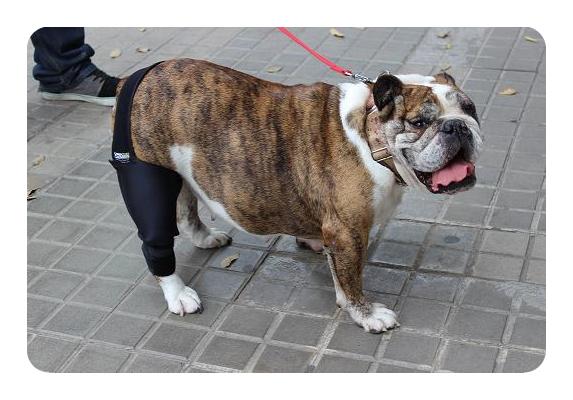Canine osteoarthritis is a very common condition in dogs. It appears as a result of the unavoidable progression of an aging joint, or when a joint becomes increasingly fragile due to trauma or malformation. It’s a very painful affliction that should be treated immediately. It can affect all of the body’s joints, in the front and hind limbs, as well as the joints in the spine. Most often in older dogs this disease affects several joints at once. A tissue called cartilage, which plays a very similar role to the shock absorbers we find in automobiles, covers the joint surface. It also prevents the underlying bone from deteriorating as result of the repeated friction it is subjected to from continuous movement. Osteoarthritis is characterized by a progressive destruction of this cartilage and an abnormal bone proliferation on the edge of the joint surfaces known as osteophytes, also called “parrot beaks” when located in the spine. The affected joints lose elasticity, causing pain and preventing the animal from moving normally.
A tissue called cartilage, which plays a very similar role to the shock absorbers we find in automobiles, covers the joint surface. It also prevents the underlying bone from deteriorating as result of the repeated friction it is subjected to from continuous movement. Osteoarthritis is characterized by a progressive destruction of this cartilage and an abnormal bone proliferation on the edge of the joint surfaces known as osteophytes, also called “parrot beaks” when located in the spine. The affected joints lose elasticity, causing pain and preventing the animal from moving normally.
Evolution of the deterioration
Generally speaking, this conditions primarily affects the high limb joints: hips and knees, shoulders and elbows. The symptoms are more or less intense depending on the number of joints affected. Nevertheless, there is an unmistakable sign that tells us the animal is afflicted. A limp usually manifests when the dog stands up and starts walking after having been still for a long time.
The pain causes the animal to avoid supporting its weight on the affected limb and, due to this limitation, the animal stops running and of course jumping. The pain increases as it progresses. The dog will emit small cries when doing certain movements and it’s even possible that the animal turns irritable and tends to be aggressive when we try and move the affected joint.
In the most advanced cases, it’s possible that joint is partially blocked making it impossible to do certain movements. Once this point has been reached, the animal hesitates to use the diseased limb. Furthermore, this lack of activity leads to a significant deterioration of the muscle that surrounds the joint. As a result, the diseased area begins to atrophy, thereby further complicating its use.
Two basic types
Generally speaking, we distinguish between two types of osteoarthritis: primary and secondary. The first type usually affects elderly animals and appears due to the normal aging that joints suffer as time passes. In reality it’s due to the progressive and unavoidable wear and tear of the joint cartilages. Normally, this type of osteoarthritis affects different areas simultaneously.
Secondary canine osteoarthritis appears following a trigger, which causes the affected joint to stop working normally. For example, this type of osteoarthritis may appear as a result of a trauma –sprain, fracture, etc.- or due to a birth defect, such as hip dysplasia.
Another very common cause that provokes the onset of secondary osteoarthritis is obesity. If you don’t control your pet’s diet then they may reach a weight well above the average for their breed. The joints aren’t made to withstand such a significant overload of kilos and as a result they deteriorate with ease. Contrary to what happens with primary osteoarthritis, the secondary can affect animals of all ages and generally only affects one joint.
The diagnosis
Diagnosing this disease can be based around three factors: the animal’s medical history, gait examination and physical examination. When studying its history, the vet should keep in mind previous joint fractures, injuries the animal has suffered long ago as well as possible sprains. By observing the gait they will be able to determine if the dog has a limp, if only very slightly and incipient, as a limp is a clear indication of the disease. Finally, by manipulating the affected area, it’s very likely that the animal will show signs of pain.
Often the region where the diseased joint is located is somewhat deformed due to the osteophytes and muscular atrophy that cause the absence of physical activity. Many times a characteristic crack is detected when we move it. Through a radiological examination, an animal health specialist will be able to determine the severity of the osteoarthritis and prescribe the most appropriate treatment plan. Among the possible treatments, using specialized supports for some of the limbs is a good option for effectively combating the deterioration of the animal’s quality of life. Using these supports is effective and have been shown to be innovative and successful in countries such as the USA, nevertheless you should check with your vet before.

